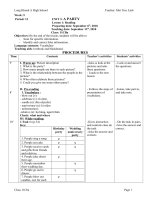Unit 3 Reading 12 (Chuan)
Bạn đang xem bản rút gọn của tài liệu. Xem và tải ngay bản đầy đủ của tài liệu tại đây (1.47 MB, 22 trang )
CLASS 12A
Money!I’m surprised .
Goodbye.Yes. Come here.
1
2
3
4
5
Yes. I’m surprised .
a.Come here
b.It’s OK
c.Hello
d.I’m surprised
3
4
1
2
Grade 12
I. BEFORE
YOU READ
* NEW WORDS:
- verbal ['və:bl] (adj) >< non-verbal
Hữu ngôn>< Phi ngôn ngữ
- formality [fɔ:'mæliti] (n) >< informality
Sự trang trọng >< Sự không trang trọng
- rude (adj) >< polite
Thô lỗ >< lịch sự
- approach /з'prout∫/ (v):
Tiếp cận
- point at/to (v):
chỉ vào
- nod (v) :
gật đầu
- wave (v):
vẫy tay
- attract one’s attention:
thu hút sự chú ý của ai
UNIT 3: WAYS OF SOCIALISING
A- READING
Líp 12
I. BEFORE
YOU READ
II. WHILE
YOU READ
Task 1: Give the suitable word for each picture below
point at
rude
formality
informality
wave
nod
UNIT 3: WAYS OF SOCIALISING
A- READING
Grade 12
A. Attracting Attention : Non – verbal Cues
B. Attracting Attention by Waving
C. The Best Ways of Attracting Attention
Líp 12
I. BEFORE
YOU READ
II. WHILE
YOU READ
Task 2: What’s the title?
Decide which of the three options below is the
best title for the passage:
UNIT 3: WAYS OF SOCIALISING
A- READING
Grade 12
Líp 12
I. BEFORE
YOU READ
II. WHILE
YOU READ
Task 3: Answer the questions
1. What can we do when we want to attract someone’s
attention?
2. What are considered to be big, obvious non-verbal
signals?
3. What can we do if we want to attract the waiter’s
attention?
4. If you are walking across the schoolyard and see
your teacher approaching you, what can you do to
attract his or her attention?
5. Why shouldn’t you point at the person or thing you
want your friend to look at once you’ve got his or
her attention?
UNIT 3: WAYS OF SOCIALISING
A- READING
Grade 12
Líp 12
I. BEFORE
YOU READ
II. WHILE
YOU READ
Task 3: Answer the questions
1. We can use either verbal or non-verbal communication.
2. They are strong actions that can easily be seen.
3. We can wait until his passes near us, catch his eye and
nod slightly to show that we need assistance
4. You can use a small friendly wave to attract his or her
attention.
5. Because it’s usually considered rude.
UNIT 3: WAYS OF SOCIALISING
A- READING
Grade 12
1. What can we do when we want to attract someone’s
attention?
2. What are considered to be big, obvious non-verbal
signals?
3. What can we do if we want to attract the waiter’s
attention?
4. If you are walking across the school yard and see
your teacher approaching you, what can you do to
attract his or her attention?
5. Why shouldn’t you point at the person or thing you
want your friend to look at once you’ve got his or
her attention?
Líp 12
I. BEFORE
YOU READ
II. WHILE
YOU READ
III. AFTER
YOU READ
What do you know about these gestures?
UNIT 3: WAYS OF SOCIALISING
A- READING
Grade 12
He wants to
say yes
In Tonga , raised eyebrows mean
Yes .
Money .
In Tonga , raised eyebrows mean yes , not
money.
He wants to say
yes.
Sorry. You are wrong !
In Vietnam, hand-clapping means
encouraging
go away!
Hand-clapping
means to
encourage
someone
Hand-clapping
means to
encourage
someone
Sorry. You are wrong !
She wants
to say No.
In Greece , a nod means
No
Yes
She wants to
say No, not
Yes.
In Greece , a nod means No , not Yes .
Sorry. You are wrong !
In Italy, flicking your chin means
Go away !
I don’t know.
Go
away
!
Sorry. You are wrong !
Go
away
!
In Italy , flicking your chin means
I don’t know
Go away !
UNIT 3: WAYS OF SOCIALISING
A- READING
Grade 12
I. BEFORE
YOU READ
II. WHILE
YOU READ
Paragraph 1
To attract someone’s attention so that we might speak to
that person, we can use either verbal or non-verbal forms of
communication. Let us look at non-verbal communication
in English. Probably the most common way of attracting
someone’s attention is by waving. For example, if we are at
a noisy party and see a friend come in the door about 20
metres away, we might raise our hand and wave to her as a
signal that we see her.
Paragraph 2
But how hard can we gave in a situation like this?
Suppose you are at the airport and you see your brother
get off the plane and begin walking towards you. If you
are excited, you might jump up and down and wave as
hard as you can to attract his attention. This is the
instance where big, obvious non-verbal signals are
appropriate.
Paragraph 3
There are, however, some social situations where smaller
non-verbal signals are more appropriate. In a restaurant, for
example, if we want to attract the attention of our waiter, we
have several choices. We can wait until he passes near us,
catch his eye, and nod slightly to let him know we would
like him to come to our table or we can raise our hand
slightly to show that we need assistance. We do not whistle
or clap our hands to get the person attention. That is
considered impolite and even rude.
Paragraph 4
In most social situations where some informality is
allowed, a brief raise of the hand and a small wave is fine.
For instance, if you are walking across the schoolyard and
see your teacher approaching you, a small friendly wave to
attract his or her attention is appropriate.
Paragraph 5
Once you have got your friend’s attention, you shouldn’t
point at the person or thing you want her to look at. A
slight nod will do. Pointing at someone is usually
considered rude. Of course, there are times when pointing
is perfectly acceptable, such as when a teacher wants to get
someone’s attention in class. The teacher often points to
the students and says, “David, would you read the next
sentence please?” Pointing here is not impolite; it simply a
way to get someone’s attention.
Clapping hands WhistlingDiscuss the meaning of whistling and
hand – clapping in Vietnamese.
When do people often whistle and clap hands?
* Whistling:
- When relaxing
- When wanting to attract other people’s attention
- When being happy,
* Hand-clapping:
- When encouraging
- When despising
- When wanting to attract other people’s attention
- Giving signal to call some one to come,
Khinh bỉ
UNIT 3: WAYS OF SOCIALISING
A- READING
Grade 12
I. BEFORE
YOU READ
II. WHILE
YOU READ
III. AFTER
YOU READ
HOMEWORK
1. Reread the passage
2. Prepare the Speaking of the Unit 3









